Gaitero teams, dancers and most people parade to the cemetery in San Jacinto, Colombia, on Aug. 14, 2022.
Karla Gachet
cover caption
toggle caption
Karla Gachet
That is a part of a particular sequence, Cumbia Throughout Latin America, a visible report throughout six nations masking the folks, locations and cultures that maintain this music style alive.
All dance was seen as rebellious throughout colonial occasions. The Caribbean coast of Colombia witnessed the delivery of cumbia within the river system of the Mompos Melancholy, an immense wetland, and in a small mountain vary often called Montes de María. Throughout the colonization of America within the sixteenth century, hundreds of enslaved people arrived from the African continent on the port of Cartagena. Pressured to depart their homeland, they introduced their music, spiritual drums and spirituality. These drums have been additionally used to ship secret messages in the course of the maroonage course of.

Diomar Trigos (from left to proper), Esneider Páez, Humberto Cañizares and Sebastián Suárez stand on the street after taking part within the Pocabuyano Parade in El Banco, Magdalena, Colombia, in the course of the Nationwide Competition of Cumbia, on Oct. 15, 2022. They’re representing the city of San Alberto, Cesar, and are carrying conventional cumbia clothes.
Ivan Kashinsky
cover caption
toggle caption
Ivan Kashinsky
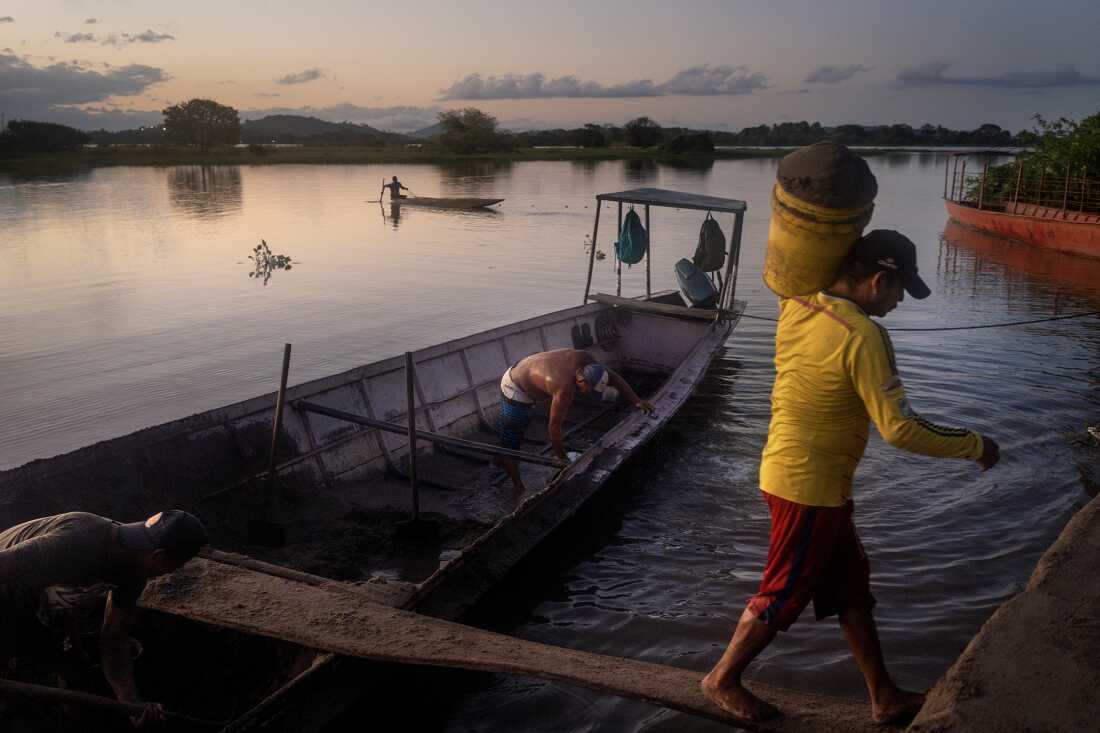
Staff unload sand collected farther down the river and delivered to El Cesar’s dock close to El Banco, Magdalena, Colombia, on Aug. 8, 2022.
Karla Gachet
cover caption
toggle caption
Karla Gachet
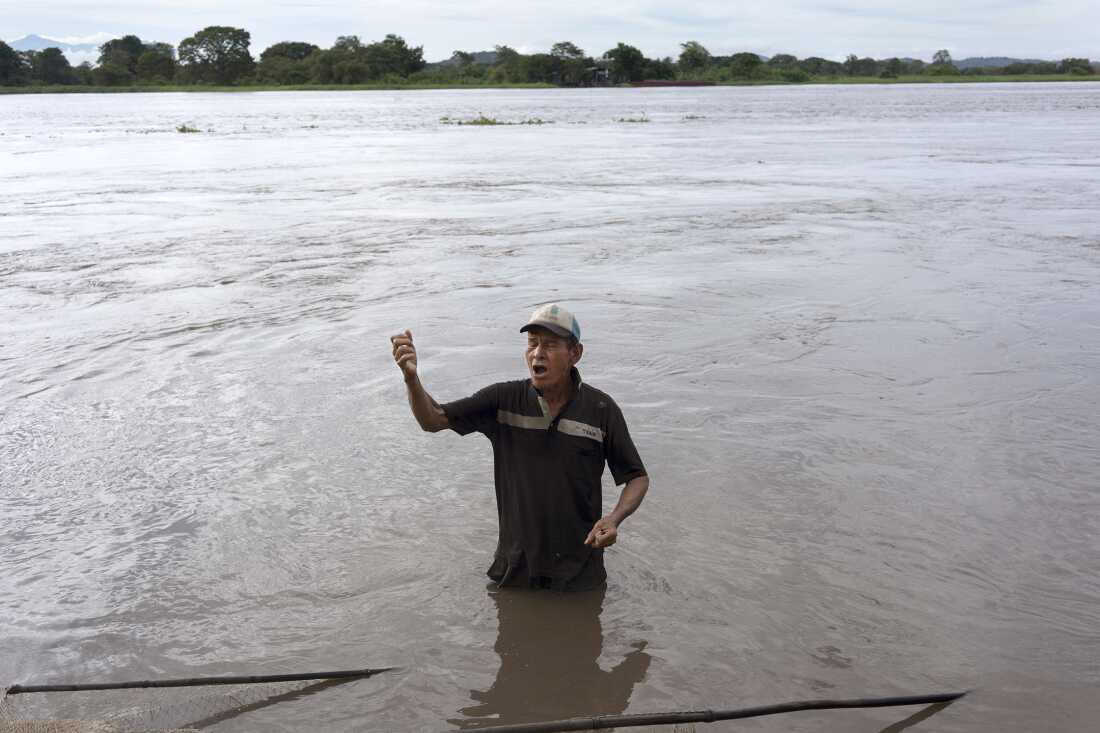
José Benito Africano Mendoza sings cumbias to folks hanging out alongside the Magdalena River in El Banco, Magdalena, Colombia, on Aug. 7, 2022.
Ivan Kashinsky
cover caption
toggle caption
Ivan Kashinsky
The swamp area was dwelling to many Indigenous cultures, now known as amphibious as a result of their proximity to water. These cultures are stated to have used flutes constituted of bone in ceremonial rites. Within the Montes de María, the place further Indigenous teams lived, small statuettes of human figures with devices resembling gaitas (Indigenous flutes) — also called chuanas — have been discovered. The clothes utilized in conventional dance, trova, and couple dancing, and the language of the songs exemplify European affect. The musical devices of this area are crafted from the earth, mimicking birds that fly alongside the banks of rivers, the sound of rain or the beating of a coronary heart.

Carlos Casas Serrano makes a tambor alegre, a standard drum utilized in cumbia, within the workshop of Colilo Lara on Aug. 12, 2022, in San Jacinto, Bolivar, Colombia, in the course of the Competition Nacional Auntóctono de Gaitas.
Ivan Kashinksy
cover caption
toggle caption
Ivan Kashinksy

A portrait of Orlando Jose Blanco Alvarez and his tambor alegre on Aug. 12, 2022, in the course of the Competition Nacional Autóctono de Gaitas in San Jacinto, Colombia.
Karla Gachet
cover caption
toggle caption
Karla Gachet
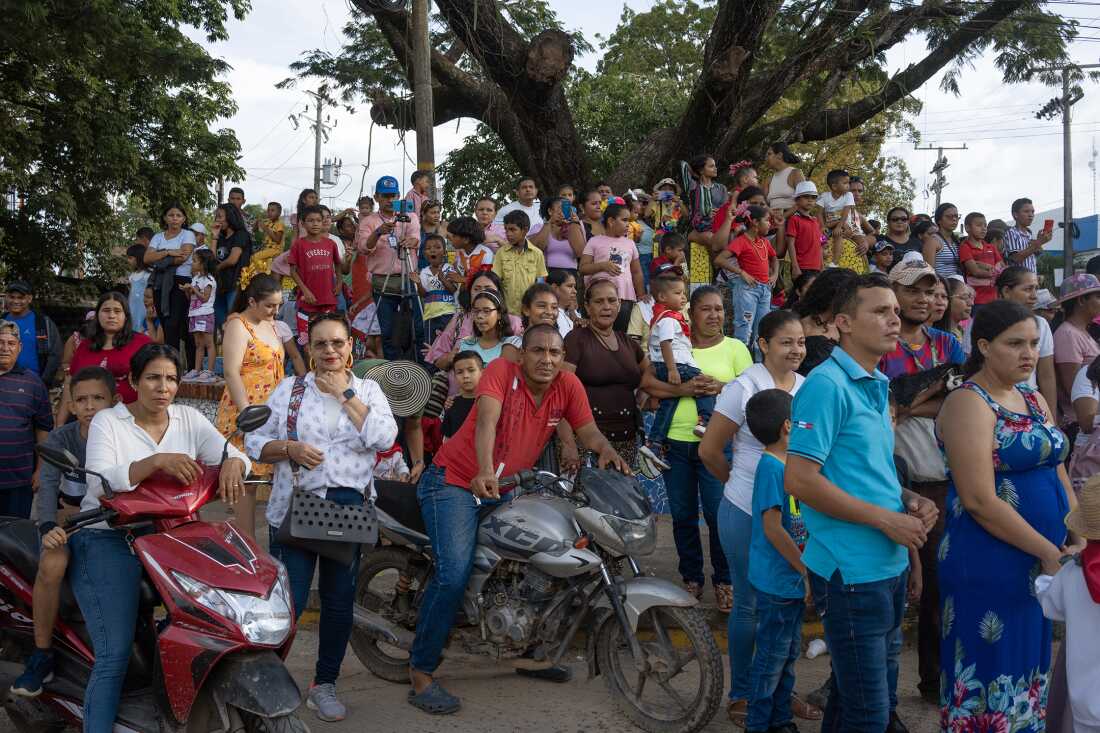
A whole bunch of individuals, dancers, musicians and cumbia queens parade by the town of El Banco, Magdalena, Colombia, in the course of the Competition Nacional de la Cumbia José Barros Palomino on Oct. 15, 2022.
Karla Gachet
cover caption
toggle caption
Karla Gachet

Yojan David Laguna Ospino and Jakelin Guillen Epalza, each 11, from the dance group Costa Azul Danza Indio Manzos, pose locally of Playa Blanca in Guamal, close to El Banco, Magdalena, Colombia, on Aug. 6, 2022.
Ivan Kashinskhy
cover caption
toggle caption
Ivan Kashinskhy

Melgen Melendez Baena, a cumbia dancer from Barranquilla, holds up his hand as Cristobal Perez Santos, 72, watches the parade of gaitero teams and dancers from his wheel chair as they transfer by the city after which to the cemetery to pay tribute to the late gaiteros on Aug. 14, 2022, in San Jacinto, Bolivar, Colombia.
Ivan Kashinksy
cover caption
toggle caption
Ivan Kashinksy

The gaita ensemble Son de Quitasol observe on Aug. 13, 2022, in the course of the Competition Nacional Autóctono de Gaitas de San Jacinto. One of many native colleges was utilized by musicians from different locations as a spot to sleep.
Karla Gachet
cover caption
toggle caption
Karla Gachet
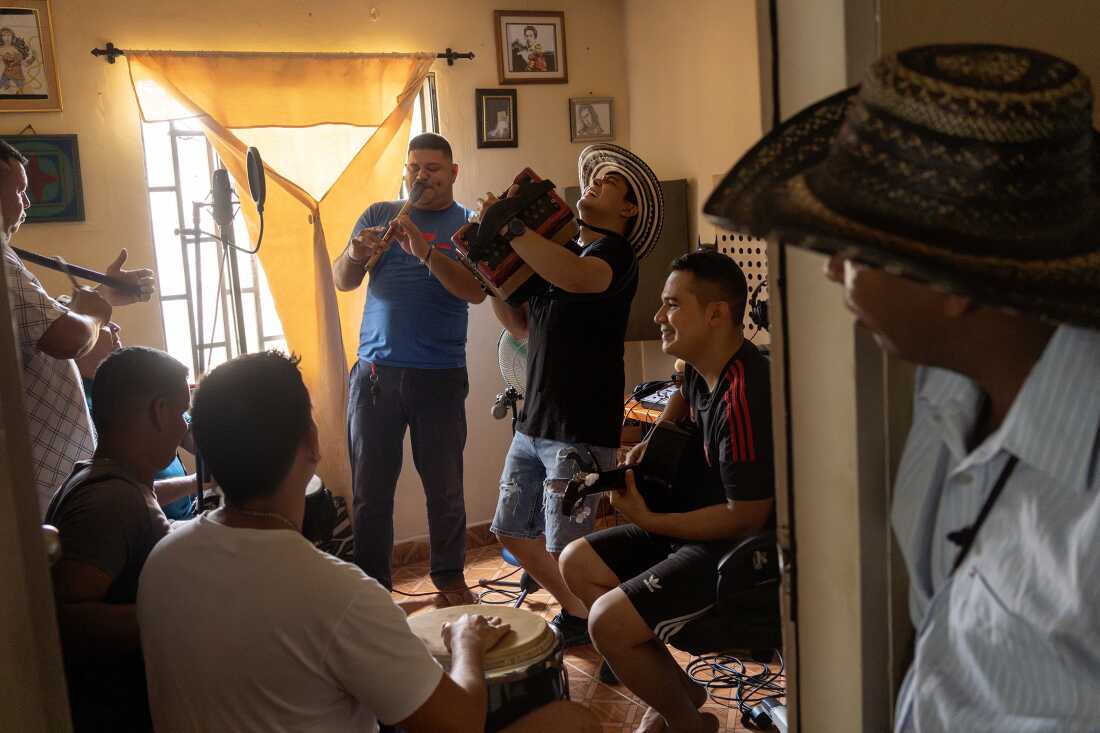
Yeison Landero, grandson of the legendary composer Andrés Landero, information a music at Estudio Mastil Récords on Aug. 12, 2022, in San Jacinto, Bolívar, Colombia, in the course of the Competition Nacional Autóctono de Gaitas.
Ivan Kashinsky
cover caption
toggle caption
Ivan Kashinsky
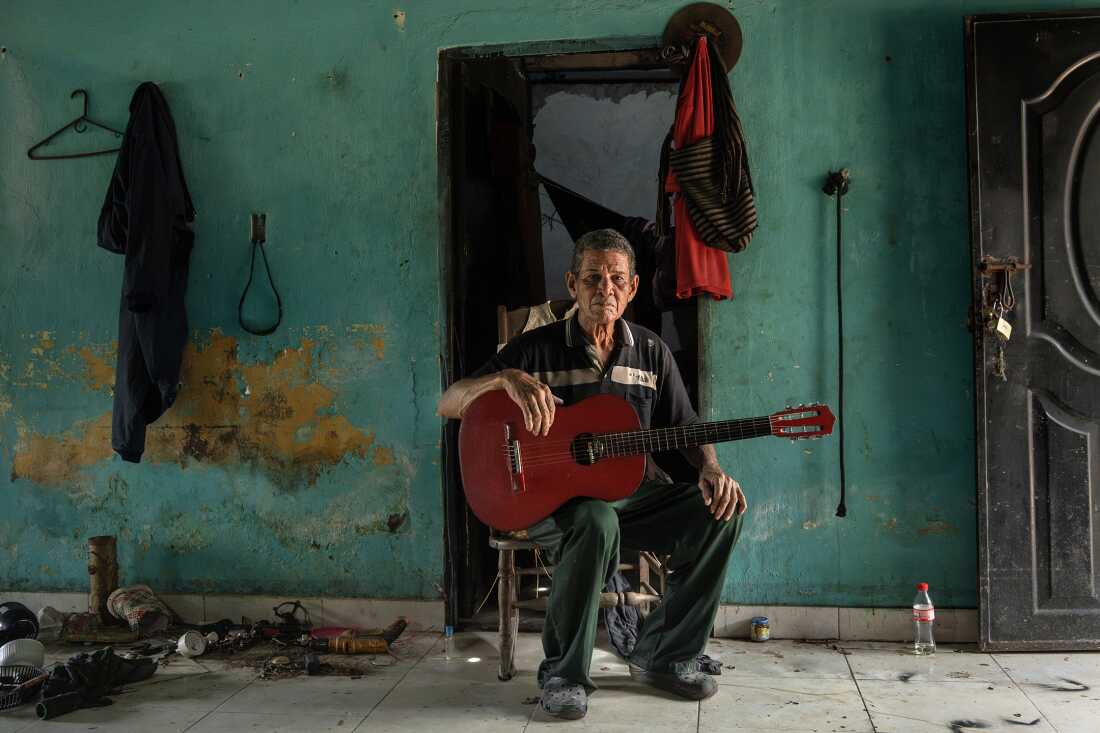
José Benito Africano Mendoza poses for a photograph along with his guitar in his dwelling in El Banco Magdalena, Colombia, on Aug. 7, 2022.
Ivan Kashinsky
cover caption
toggle caption
Ivan Kashinsky
Emilia Reyes Salgado, often called “la Burgos la Meya,” is among the greatest bullerengue singers from San Basilio de Palenque, the primary free city in America. Half an hour away, in Arjona, resides Petrona Martinez, the winner of the 2021 Latin Grammy for greatest folks album, with Ancestras. In María la Baja lives Pabla Flores, who comes from a lineage of singers and has established a college in honor of her mom, who taught her to sing. The African roots of cumbia are expressed not solely by its percussion devices — the tambor alegre, the llamador and the tambora — but in addition by the voices of ancestors mirrored within the sung dances of the area. Black and Afro-descendant girls in Colombia are on the coronary heart of those songs, transmitting this legacy from era to era.

Ana Regina Ardila Matos poses for a portrait in her hometown of San Martín de Loba, Bolívar, Colombia, on Aug. 5, 2022. Ardila is a cantadora of a rhythm known as tambora, which makes use of the identical devices as cumbia and is intently associated. She comes from a convention of cantadoras — girls who compose songs about every day life and cross them down by oral custom.
Karla Gachet
cover caption
toggle caption
Karla Gachet

Elida Cañates braids extensions on Suleidis Villegas’ hair on Aug. 4, 2022, in Palenque de San Basilio, Colombia. The particular fashion is named “caminos.”
Karla Gachet
cover caption
toggle caption
Karla Gachet
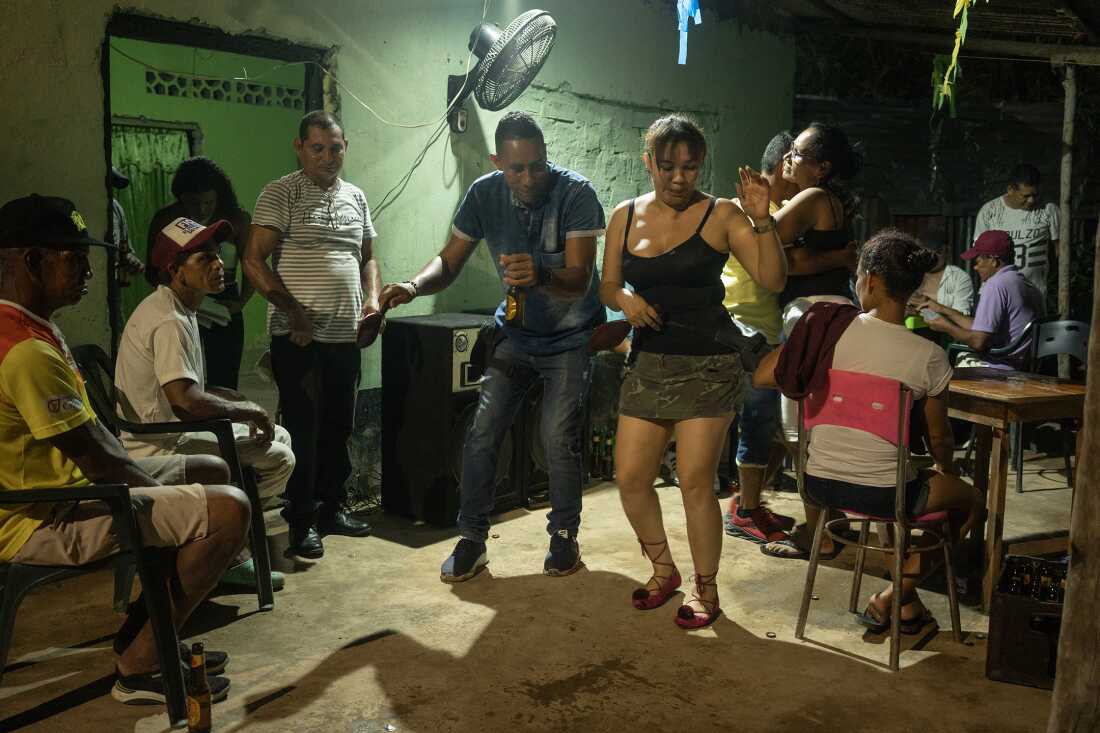

Daybreak illuminates the dock and the Magdalena River in El Banco Magdalena, Colombia, on Aug. 9, 2022. The tradition of the realm, together with cumbia, is deeply tied to the river and the fishermen.
Ivan Kashinsky
cover caption
toggle caption
Ivan Kashinsky
San Jacinto, situated within the Montes de María, is the epicenter of gaita music, well-known for the Gaiteros de San Jacinto and the cumbia of Andrés Landero, some of the beloved accordionists in Latin America. Traditionally, this area was additionally the territory of the FARC (Revolutionary Armed Entrance of Colombia). It’s stated that guerrillas would permit musicians to cross in the event that they displayed their devices. Amid a civil warfare lasting over half a century, the gaita — a pre-Hispanic flute constituted of the center of a cactus and a duck’s feather — turned an emblem of peace. These Indigenous sounds breathe life into cumbia.
Jose Benito Barros, initially from El Banco, Magdalena, wrote “La Piragua” and “El Pescador,” iconic Colombian cumbias. Early in his profession, Barros didn’t carry out the normal rhythms of his area. This music, rooted within the experiences of fishermen and individuals who recite lyrics on the banks of the Magdalena River, was not initially accepted by the center and higher lessons of that point. Nonetheless, upon realizing the recognition of those rhythms, Barros shifted his musical path. In 1970, he held the primary cumbia pageant in El Banco, serving each as a choose and participant. His daughters, together with native elites, proceed to host this pageant yearly. Whereas the primary port is embellished to impress the invited authorities, just some blocks away, probably the most marginalized neighborhoods proceed to face extortion from small armed teams.

Ingrid Cifuentes dances with candles as folks play gaitas and drums and dance cumbia in the primary plaza on Aug. 13, 2022, in San Jacinto, Bolivar, Colombia, in the course of the Competition Nacional Auntóctono de Gaitas. Gaita is a standard instrument constituted of a cactus and is tied to the origins of cumbia.
Ivan Kashinksy
cover caption
toggle caption
Ivan Kashinksy
This protection was made with the help of the Nationwide Geographic Society Explorer program.
Karla Gachet and Ivan Kashinsky are photojournalists primarily based in Los Angeles. You may see extra of Karla’s work on her web site, KarlaGachet.com, or on Instagram, at @kchete77. Ivan’s work is offered on his web site, IvanKphoto.com, or on Instagram, at @ivankphoto.




